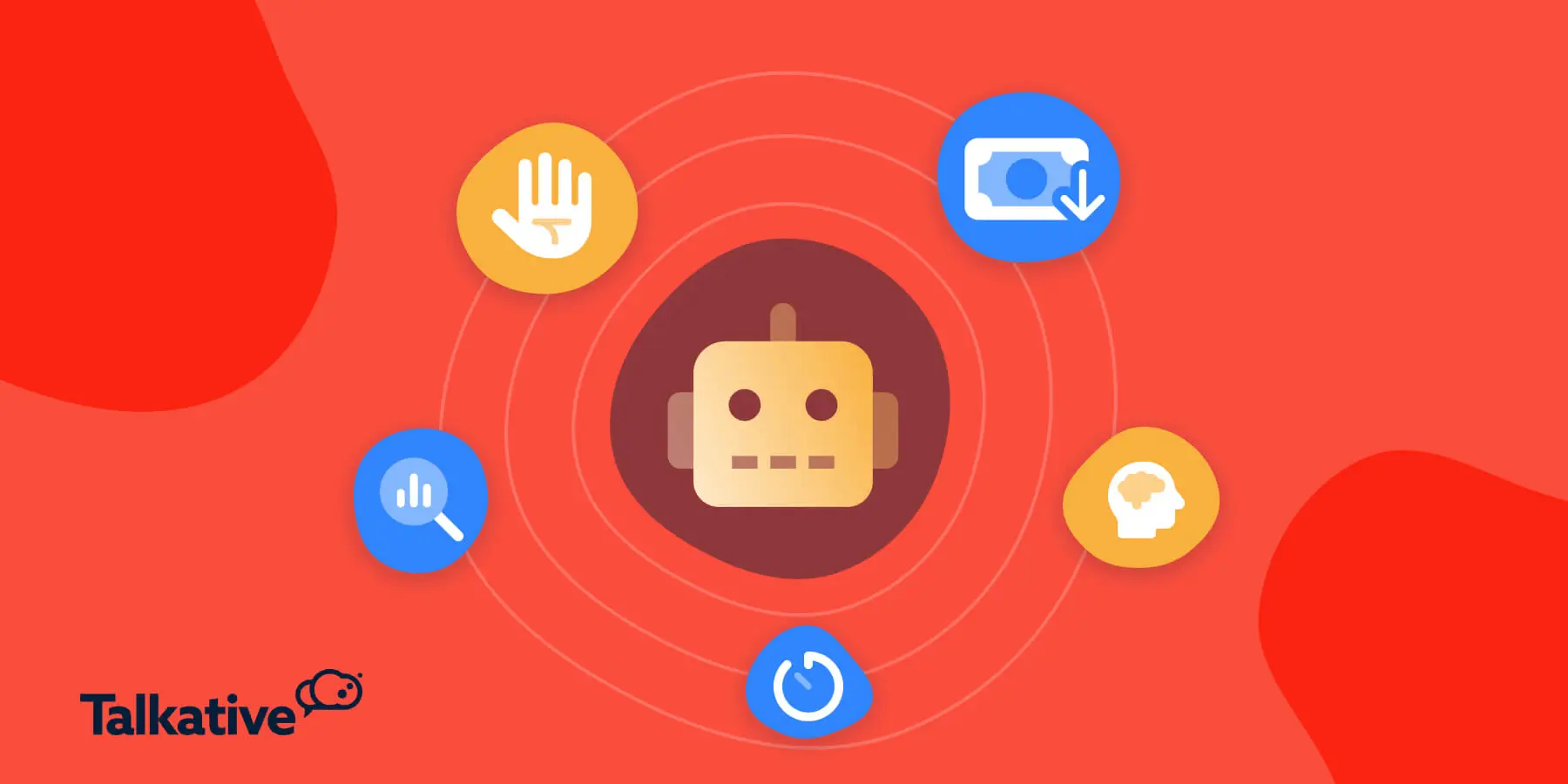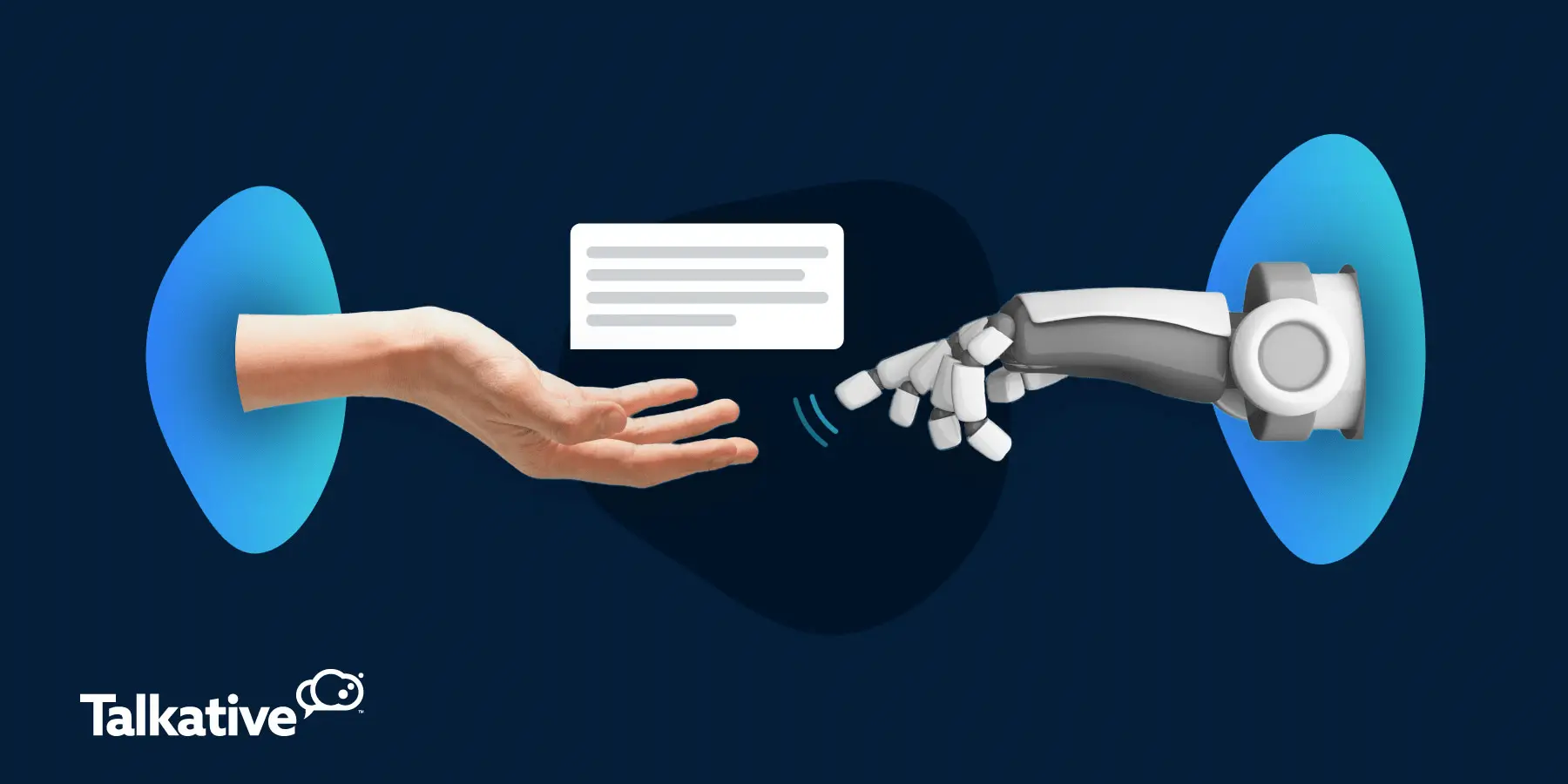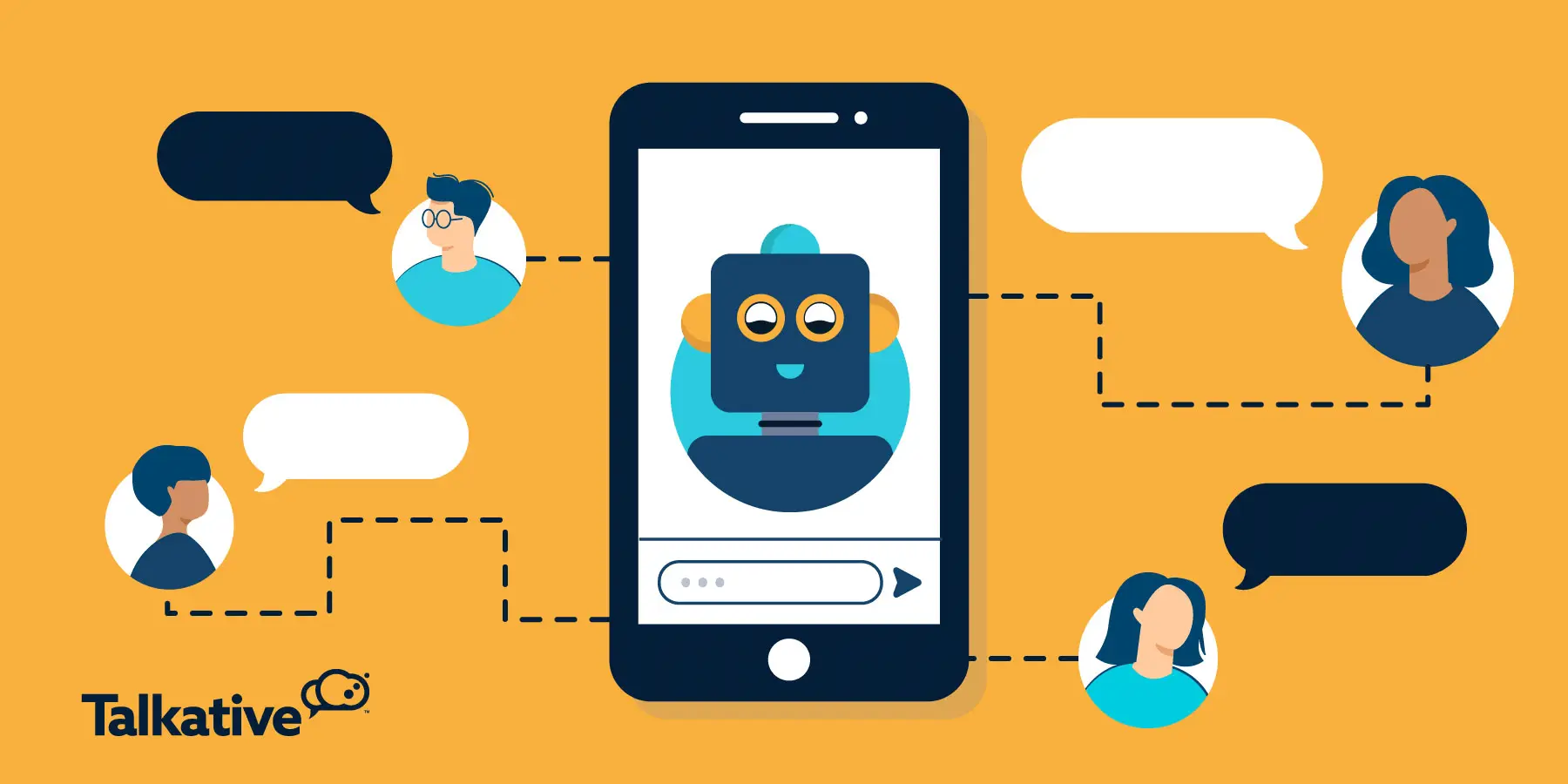Insurance is a complex product with an equally intricate buying journey.
Consumers looking to purchase insurance aren’t likely to do so on a whim. The process is often lengthy, involving careful research and consideration.
In fact, 74% of consumers use insurer websites to research policies and compare quotes before purchasing.
With this in mind, insurance providers must be able to meet potential customers where they are - allowing them to ask questions and access information at crucial stages of the digital journey.
One way insurance companies can do this is by implementing a specialised chatbot.
Insurance chatbots work by acting as virtual advisors, providing expertise and assisting customers around the clock.
But, if you want to get the best results, you need to know what an insurance chatbot can actually achieve and how to get the most out of this technology.
That’s why we’ve put together an essential guide on the subject. We’ll cover:
- What are insurance chatbots?
- Benefits of chatbots for insurance agencies
- Top use cases for chatbots in the insurance industry
- How to use an insurance chatbot for customer support: Best practices
TL;DR
An insurance chatbot is a virtual assistant designed to serve insurance companies and their customers.
- Key benefits: Improved customer self-service, reduced support costs, increased efficiency, automated data collection.
- Top use cases: Advising potential customers, assisting policyholders/brokers/third parties, automating claims processing, generating quotes, managing insurance plans, facilitating insurance payments.
- Best practices: Choose the right chatbot model for your business needs, integrate with an AI knowledge base, allow seamless hand-offs to human agents when needed, ensure data security, implement continuous improvement strategies.

What are insurance chatbots?
Insurance chatbots are advanced virtual agents designed to meet the specific needs of insurance providers.
These systems often leverage artificial intelligence technologies (e.g. natural language processing, machine learning, generative AI) to process information and interact with users in a conversational manner.
Whether it’s answering questions about insurance policies, processing claims, or providing quotes, an insurance chatbot can be programmed to handle a wide range of tasks efficiently and accurately.
It can also be deployed across multiple digital touchpoints, including your company website, app, and messaging platforms like SMS or WhatsApp.

Benefits of insurance company chatbots
Chatbots can benefit insurance firms in a number of ways, including…
- Improved customer self-service: Insurance bots answer customer questions, allowing them to get instant support and perform tasks independently. This is key as 40% of consumers prefer self-service over human contact, and 81% want businesses to offer more self-service channels. Better self-service means the number of cases needing human intervention decreases, leading to lesser agent workloads, reduced wait times, and a better overall customer experience.
- Reduced support costs: Chatbots can slash customer support costs by 30%. They achieve this by automating numerous customer interactions and tasks, allowing for better resource allocation. They’re also a far more cost-effective solution for managing high volumes of customer queries compared to hiring additional agents.
- Increased efficiency: Introducing a customer service chatbot can yield significant efficiency gains within the insurance sector. By streamlining digital customer service and reducing the demand on support teams, chatbots help businesses save time and achieve higher agent productivity.
- Data collection: Chatbots are a great tool for collecting and analysing user data. This not only helps with lead generation and marketing but also provides insurance companies with valuable insights into customer preferences, behaviours, and needs.
By leveraging chatbots, insurance companies can improve their digital CX while optimising performance and efficiency - ultimately leading to a more competitive and customer-centric business model.

Key use cases for chatbots in the insurance industry
Insurance chatbots can streamline support and automate huge volumes of customer conversations, completely transforming insurance communication operations.
Below, we’ll explore 6 key use cases for chatbots in the insurance industry.
1. Advising potential customers
Chatbots serve as the first point of contact for potential insurance customers, offering 24/7 assistance to those exploring insurance options.
By digitally engaging visitors on your company website or app, insurance chatbots can provide guidance that’s tailored to their needs.
This makes it much quicker and easier for users to access the information they need for their specific situation, creating a convenient and personalised customer experience.
An insurance chatbot can help new customers in numerous ways, including:
- Answering queries about different insurance products and coverage options.
- Providing accurate information on premiums, deductibles, and insurance policies.
- Offering policy recommendations based on the customer’s situation and requirements.
- Guiding users through the insurance purchasing process step-by-step.
- Explaining complex insurance concepts in simple, user-friendly language.
- Directing visitors to relevant resources such as FAQs, articles, or customer reviews.
- Escalating to an appropriate support agent if needed.
By providing instant and personalised support, insurance chatbots empower potential policyholders to make informed decisions and seamlessly navigate insurance processes.
2. Assisting policyholders, brokers, & third parties
The scope of insurance chatbots goes beyond assisting potential customers.
After you’ve converted an enquiry into an existing customer/policyholder, chatbots continue to play an important role in providing ongoing support.
Policyholders can use your chatbot to verify policy details/terms, request assistance with coverage adjustments, or seek help with other tasks such as filing a claim (more on this below).
And it’s not just policyholders who benefit from an insurance chatbot - insurance professionals (e.g. brokers) and third parties can also utilise this service.
For brokers, insurance chatbots streamline communication, enabling them to quickly access policy information, generate quotes, and facilitate transactions on behalf of their clients.
Third parties, such as repair contractors or legal professionals, can use chatbots to expedite the insurance claims process by submitting documentation and receiving real-time updates.
In essence, insurance chatbots can be viewed as versatile virtual assistants capable of helping all customers and stakeholders involved in the insurance ecosystem.

3. Processing insurance claims
In the event of an accident or unexpected loss, filing an insurance claim can be a daunting task.
Insurance chatbots simplify this process by guiding policyholders through the necessary steps required.
Customers can use the bot to submit details about their claim, such as the incident date, description, and relevant documentation.
In turn, the insurance chatbot can promptly assess the information provided, offering personalised advice on the next steps and assisting users with any required forms.
It can also review claims to detect inconsistencies or suspicious activities during interactions, allowing you to flag potential fraudulent details.
Additionally, insurance bots can provide updates on the status of existing claims and answer any further queries, ensuring transparency and clarity throughout the process.
From capturing relevant information to fraud detection and status updates, chatbots help automate and streamline claims processing.
This significantly reduces the time and effort required from both policyholders and your insurance company teams.
4. Generating insurance quotes
Obtaining insurance quotes traditionally involves filling out lengthy forms or speaking with a representative.
With insurance chatbots, individuals can receive personalised insurance quotes quickly and effortlessly.
Through questioning, a chatbot can collect essential information from users, such as their demographics, insurance needs, and coverage preferences.
The information provided can then be analysed by the bot to generate an insurance quote tailored to the individual’s requirements.
This streamlined process not only saves time but also ensures accuracy, as the chatbot eliminates potential errors that might arise from manual input.
What’s more, chatbots can offer explanations about various policy options, clarify doubts, and guide users through the quoting process, empowering them to make informed decisions about their insurance needs.
Overall, an insurance chatbot simplifies the quote generation process, making it more accessible and convenient for customers while enhancing their understanding of available options.

5. Managing insurance plans
Managing insurance accounts and plans can be complex, especially for individuals with multiple policies or coverage options.
Insurance bots simplify account management by facilitating self-service and helping policyholders perform tasks, such as:
- Updating personal information
- Making coverage adjustments
- Reviewing policy documents
- Policy renewals
Automating these tasks through a chatbot will prevent your insurance agents from being overloaded with repetitive tasks/interactions, enabling them to dedicate more time to complex issues.
It’ll also empower your customers to take control of their insurance experience with minimum effort.
6. Taking insurance payments
Gone are the days of waiting on hold to make an insurance payment over the phone.
Insurance chatbots can help policyholders to make online payments easily and securely.
Whether it’s a one-time payment or setting up recurring payments, chatbots facilitate seamless transactions, offering maximum convenience.
Chatbots also offer flexibility in managing payment methods, allowing policyholders to update their preferred payment methods or review payment history.
Overall, insurance chatbots enhance the payment experience for policyholders, offering convenience, security, and peace of mind in managing their insurance premiums.

How to use an insurance chatbot for customer service: Best practices
Like any customer communication channel, chatbots must be implemented and used properly to succeed.
The following best practices will help you get the most out of your insurance bot support.
1. Choose the right kind of chatbot
When implementing an insurance chatbot, you’ll likely have to decide between an AI-powered chatbot or a rule/intent-based model.
Rule-based chatbots are programmed with decision trees and scripted messages and often depend on the customer using specific words and phrases.
These bots can be a valuable tool for FAQs, but they’re extremely limited in the type of queries they can answer - often leading to a frustrating and “bot-like" user experience.
AI-driven insurance chatbots, by contrast, are designed and trained to handle a huge range of queries, tasks, and interactions.
Rather than relying on predetermined decision trees, AI chatbot solutions leverage machine learning (ML), natural language processing (NLP), conversational AI, and/or generative AI.
These technologies allow AI-powered systems to understand a customer’s message and produce detailed, human-like outputs.
Of course, even an AI insurance chatbot has limitations - no bot can resolve every single customer issue that arises.
But, thanks to the power of AI, an insurance chatbot can evolve and be trained to handle an increasingly wide range of queries/tasks.
If you’re not sure which type of chatbot is right for your insurance company, think about your specific business needs.
For example, a small business or start-up will have very different chatbot needs compared to an international brand looking for an enterprise chatbot solution.
You also need to take into account your objectives and customer service goals.
In other words - what do you want your chatbot to do/achieve for your organisation?
If you want a bot that can create a humanised experience, handle a variety of customer conversations, and provide the most advanced automated support - an AI-enhanced chatbot is the best choice.
On the other hand, if you simply want to take FAQs and repetitive tasks off your support agents’ plate, a rule-based chatbot might work well enough for you - so long as you choose the right provider.
Fortunately, Talkative offers the choice between an AI solution, a rule/intent-based model, or a combination of the two.
It means you’ll have all bases covered with us - whatever your business needs.

2. Integrate with an AI knowledge base
Integrating your bot with an AI knowledge base can significantly enhance its capabilities and scope.
Knowledge base content gives chatbots access to a vast repository of information and expertise that’s specific to your organisation.
By tapping into this database, chatbots can offer highly detailed and relevant responses to a vast range of user inputs, leading to improved customer engagement and increased customer satisfaction.
This is particularly valuable for insurance companies, as they possess huge amounts of information regarding policies, coverage details, claims processes, frequently asked questions, etc.
With Talkative, you can easily create an AI knowledge base using URLs from your business website, plus any file-based content or resources.
You can then integrate the knowledge base with our GenAI Chatbot, effectively training the bot on its content.
From there, the bot can answer countless questions about your business, products, and services - using relevant data from your knowledge base plus generative AI.
It means you’ll be safe in the knowledge that your chatbot can provide accurate information, consistent responses, and the most humanised experience possible.
Just remember that regular updates and maintenance of the knowledge base are necessary to ensure your chatbot remains up-to-date with the latest insurance product offerings and regulatory changes.

3. Use alongside human-powered support
It’s important to remember that chatbots are not a customer service cure-all.
Even with advanced, AI-powered insurance chatbots, there will still be cases that require human assistance for a satisfactory resolution.
In these instances, it’s essential that your chatbot can execute seamless hand-offs to a human agent.
In fact, a smooth escalation from bot to representative has been shown to make 60% of consumers more likely to stay loyal to a business.
Neglect to offer this, and your chatbot’s user experience and adoption rate will suffer - preventing you from gaining the benefits of automation and AI customer service.
You’ll also risk alienating customers and may gain a reputation for poor customer service.
Thankfully, with platforms like Talkative, you can integrate a chatbot with your other customer contact channels (e.g. live chat, SMS, WhatsApp).
By doing this, you’ll facilitate effortless transitions between them, creating a cohesive and seamless customer experience across all touchpoints.

4. Ensure data security
Data security is a critical consideration for all customer support channels - and chatbots are no exception.
Insurers handle sensitive personal and financial information, so it’s imperative that you safeguard customer data against unauthorised access and breaches.
Here are some specifics to consider for chatbot software security:
- Data protection policies: Make sure your chosen chatbot platform has robust policies and controls in place for customer privacy, including how data is stored, who can access it, and how it’s used. Check the provider’s privacy policy to ensure your data is not being shared or sold to third parties without your consent.
- Regular software updates: Your chatbot provider should conduct regular software updates to address security vulnerabilities and ensure that its systems are up to date with the latest measures.
- Compliance: Depending on the location of your insurance company, you’ll likely have to choose a chatbot solution that complies with specific regulations, such as HIPAA in the US and GDPR in the European Union.
By adhering to robust security and privacy measures, you’ll protect any confidential information that’s transmitted through the chatbot, instilling trust and confidence among policyholders.

5. Implement continuous improvement & feedback mechanisms
The practice of continuously monitoring and improving your bot’s performance is essential for long-term success.
You can refine an insurance chatbot’s performance over time with the following strategies:
- Metrics tracking: Identify the performance metrics and chatbot analytics that align with your business objectives. Key metrics for chatbot performance include- error and escalation rate, resolution rate, handling time, CSAT score, and abandonment rate.
- Customer feedback: Implement customer feedback tools, such as post-interaction feedback forms or ratings, within your insurance chatbot’s interface. Use this feedback to make targeted improvements to the chatbot’s training and capabilities.
- Quality assurance testing: Quality assurance involves testing your chatbot’s functionality, ensuring it operates seamlessly across different platforms and devices while maintaining consistency in performance. This process helps uncover any technical glitches, compatibility issues, or inconsistencies in responses.
By undertaking continuous performance management, you’ll ensure that your chatbot is actually adding value to your insurance operations - and the customer experience.

The takeaway
Chatbots can be a game-changer for the insurance sector.
By leveraging the power of automation, chatbots not only improve operational efficiency for insurers but also empower insurance customers with instant access to information and support whenever they need it.
But for any chatbot to succeed, it must be powered by the right technology.
That’s where Talkative comes in.
Our platform provides a scalable and flexible chatbot solution that can be tailored to your specific business needs.
With a Talkative chatbot, you can:
- Choose between an AI-powered or intent/rule-based bot (or a combined approach - an AI chatbot with rule-based fall-back for maximum efficiency)
- Integrate with an AI knowledge base to create expert virtual advisors
- Serve potential customers, policyholders, brokers, and third parties across your website, app, and messaging channels
- Seamlessly escalate to human agents when needed
- Build multiple chatbots in-house (if you prefer to take the wheel with bot design)
In addition to chatbots an AI solutions, we offer a complete suite of customer contact channels and capabilities - including live chat, web calling, video chat, cobrowse, messaging, and more.
Our solution also supports numerous integrations into other contact centre systems and CRMs. In fact, our Salesforce integration is one of the most in-depth on the market.
Book a demo with Talkative today and check out our interactive product tour.



